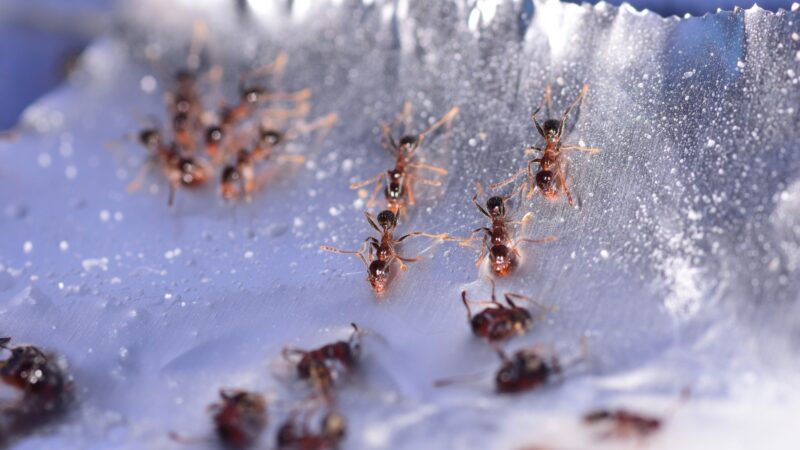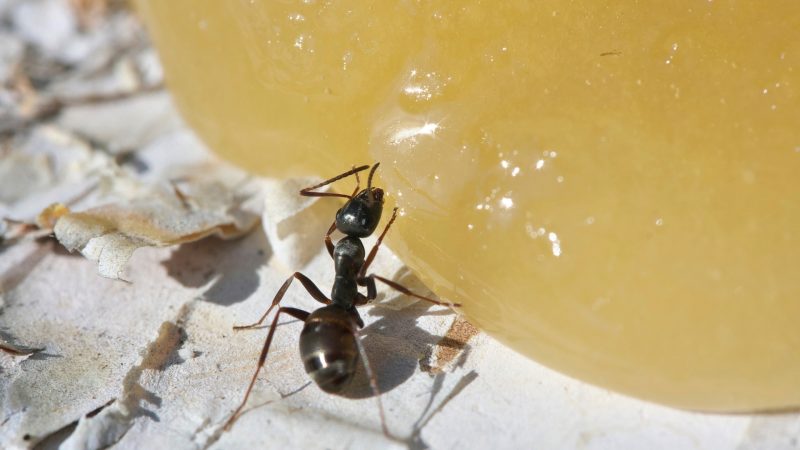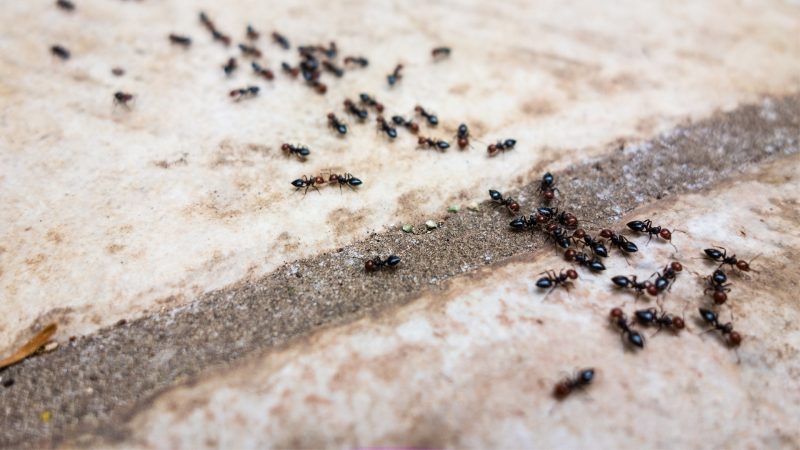Battling pesky ant invasions? Discover the best ant baits to banish ants from your home and yard! Ant baiting ranks as a highly effective strategy for ousting these unwelcome guests.
Ant traps or baits: the ultimate solution for eliminating stubborn colonies. Though it takes patience, the payoff beats alternative approaches.
Ant bait magic: a potent mix of insecticides and ant-attracting grub. Enticed ants grab the bait, sharing it with their nest mates. Soon, the entire colony—including the queen—meets its demise.
What Are Ant Traps?
Ant traps use bait that includes poison as one of the ingredients. The bait is typically sweet or protein-based that attracts ants.
Although they will also bring large amounts of the bait back to their colony, they do consume part of it themselves. As they consume the food, the colony’s ants will progressively perish from the poison.
Best Ant Baits | Information

Ant baits come in various commercial forms and are known for their effectiveness and low toxicity compared to other ant killers. However, it’s essential to choose the right bait for the specific ant species to achieve the desired results. Different ant species are attracted to different types of bait.
Do Ant Baits Work and How Effective Are They?
As Pest Professional and someone who has dealt with ant infestations in my own garden, I can attest to the effectiveness of ant baiting. It’s a powerful and long-lasting solution for most ant problems. Although it’s a slower process than using ant killer sprays or other insecticides, it’s safer and more effective in the long run.
Related: Do Dead Ants Attract More Ants? | The Play-Dead Phenomenon!
How Does Ant Bait Work | Detailed Explanation

To understand how baits work, it’s essential to first learn about ants’ behavior and life patterns. Ant colonies consist of various castes, including worker ants, soldiers, queens, and male reproductives. The colony’s queen lays eggs, while male reproductives aid in mating and soldier ants protect the colony from threats. Worker ants collect food to support the entire colony, including the larvae.
Commercially prepared ant baits cater to the food preferences of different ant species, combining specific food types and insecticides. When worker ants are attracted to the bait, they carry it back to their nests, effectively targeting the entire colony. Best ant baits take time to work as they have low toxicity and do not kill ants upon contact.
Related: What Attracts Ants? Information and Facts
How Long Does It Take for Ant Bait to Work?
Ant baiting is a slow-acting process, taking anywhere from one to two days to a few weeks, depending on the size of the colony and the degree of infestation.
Is Ant Bait Toxic to Dogs, Cats, and Other Pets?

Ant baits typically contain low-toxicity ingredients, making them safer than other ant killers. However, accidental exposure may cause nausea, vomiting, or irritation in children, dogs, cats, and other pets. Keep baits out of reach of children and pets to ensure safety.
Types of Ant Baits | Traps, Gels, Granules, Stations
Various forms of sugar-based or grease-based baits are available for ant control in indoor and outdoor infested areas. These include ant traps, liquid baits and bait stations, gel baits, and solid or granular baits.
Ant Traps
Ant traps lure worker ants to carry the bait back to their nests, ultimately eliminating the entire colony. Place the traps near ant trails, entry points, or wherever you find ants.
Liquid Baits and Bait Stations
Bait stations are containers that hold ant bait, keeping it fresh and limiting exposure to children and pets. They can be placed near access points, ant trails, or installed into the ground.
Gel Baits
Gel baits are applied near cracks, holes, or other inaccessible areas. Use disposable containers, paper, or tape to apply the gel near ant trails or cracks.
Solid | Granular baits
Granular baits are best for outdoor pest control. Spread them near nesting sites, cracks, or holes, and along the foundation of your house.
Differences Between Different Types of Ant Baits
Different types of solid, gel, and liquid ant baits are available commercially. Every bait is specified for a particular group of ant species according to their feeding cycle and dietary needs. Some ant baits contain sugar-based or carbohydrate-based types of food that attract a specific group of ant species.
For example, best ant baits with sugar attract a group of ants called sugar ants, while protein-based baits attract a group called grease ants. Some baits can work on a variety of ant species (broad-spectrum baits). Liquid baits are mostly sugar baits whereas solid baits are usually protein-based baits.
What to Look for in an Ant Killer?
Safe for Homes
Consider the active component while selecting an ant repellent. Plant-based essential oils like lemongrass are found in natural products that are suitable for children and animals.
Pets and children should never swallow excessive amounts of ingredients like borax and pyrethrins. Consider a natural option with only four components if you have pets or children at home.
Formula
There are two sorts of ant killers that you will probably find when shopping: contact and bait killers. Ants can take the poison back to their nest if the bait is designed to kill them gradually. Although this is a slow process, it effectively wipes out the entire population.
On the other hand, for contact killers to work, an insect must be exposed to them directly. Although it usually kills the bug right away, this method won’t stop future ants from accessing your home.
Effective Time
Ants can be killed more slowly with baits than with contact sprays, such as the granules you can spread about the outside of your house. Spraying solutions causes instantaneous death upon contact. A direct impact on the insect is essential.
How to Use Ant Bait Stations: Instructions and Tips (Indoor and Outdoor)
Before using baits you need to identify the ant species and investigate the infested site. The accurate identification of ant species is necessary to select the right type of ant bait. Inspect the level of infestation, the behavior of ants, and their food habits.
The ant baits are most effective at a specific time period and may not attract the ant throughout the whole year. For instance, Argentine ants are attracted to sweet baits during the whole year but prefer protein baits during the spring season. You can also put small quantities of different ant baits near their active site to test their food preference.
Further, we have given a step-by-step guide on how to use ant baits for both indoor and outdoor pest control.
Step 1: Investigation of Active Sites

Investigate the active site and identify the type of ant in order to select suitable bait and determine the number of required bait stations. Follow the ant trails and observe their active site and access points for several days. Inspect the feeding cycle and notice the timings when ants are most active throughout the day and night.
Step 2: Place the Bait Station
Bait stations may contain liquid, gel, or solid baits. Select the best bait for the specific ant species. For indoor pest control, place the bait stations near the ant trails, along with nesting sites of ants, near cupboards, at counters, or where it is needed. Wait for a couple of days and expect amazing results. Change the bait if ants are not attracted to the particular bait.
In outdoor infested areas, put the bait station near ant mounds, beneath plants, near ant trails, or where ants are active the most. You can also install them permanently near the pavement or underground. Keep the bait station at about 10 to 20 feet away along the foundation or near access points.
Refresh and change the baits after every few weeks until you completely eradicate the ants. For larger infestations, place the bait stations at multiple sites. You will see results in 3 to 4 days. You can also use different types (solid, and liquid) of sugar and grease baits simultaneously.
Most of the baits or bait stations are for both indoor and outdoor use but some are strictly labeled for outdoor pest control.
Step 3: Prevent Reinfestation
Observe the treated area for several days after the treatment. Re-fill the bait in the bait stations if needed. Remove all the factors that can attract ants into your house or garden. Try using ant repellents or insect repellent plants to avoid re-establishment or invasion of ants.
Review: Top 3 Best Indoor Ant Baits
TERRO T300 Liquid Ant Bait
- ATTRACTS & KILLS: Effectively targets and eliminates common...
- KILLS THE ANTS YOU DON'T SEE: Terro ant bait is designed to share...
- FAST-ACTING: Noticeable ant activity reduction within days as...
- READY TO USE: Simply place ant baits indoors with no setup...
- VERSATILE HOME PLACEMENT: Ideal for use as terro ant traps along...
TERRO T300 Liquid Ant Bait is one of the best recommended indoor ant baits. This ant bait includes 12 baits station. The bait stations come in ready-to-use, pre-filled packing. Its patented design prevents the liquid bait from drying out. The active ingredient used inside bait is borax. Place the bait stations near ant trails and where you see ant activity.
Syngenta – Optigard Ant Bait Gel Box
- OPTIMAL CONTROL: Optigard Ant Gel Bait from Syngenta is a...
- EASY APPLICATION: This stainless, odorless ant bait is known for...
- TARGETS ALL MAJOR SPECIES: The sugar-based gel matrix of Optigard...
- EFFICIENT ANT CONTROL: Other baits can be too runny, which...
- COMPACT PACKAGING: Optigard Ant Gel Bait is packaged in...
This is a highly rated indoor ant killer bait. It is capable of killing entire ant colonies. Put the bait on a piece of the cupboard, paper, or any other substitute and place it near the active zones of ants and you will get amazing results.
Home Plus Ant Killer
- Metal Ant Killer Bait: Attracts and kills many different species...
- Food Lure Ant Bait: The child-resistant metal bait stations use 4...
- How it Works: Worker ants carry and share the bait with the rest...
- Quick Results: Starts killing worker ants within 24 hours; you...
- Usage: Homeplus Ant Killer AB baits are great for getting rid of...
Home Plus Ant Killer is one of the best ways to eradicate ant colonies in indoor-infested areas. This ant bait kills the entire ant colony including the queen. These bait stations can last you a long time. They do not only kill ants but also prevent their re-infestation.
Aunt Fannie’s Ant
- Take care of business without harsh chemicals or nasty odors with...
- Intended for indoor use where ants appear
- Safe around children and pets when used as directed
- Hard working with a fresh scent that actually smells good; each...
- Manufactured in the USA; free from harsh chemicals
For those who live with furry family members, this is a fantastic solution. This solution contains rosemary essential oil, a natural insect repellent that is very powerful against ants, so you may safely bid them farewell while your children and dogs are around.
This treatment must be applied directly to the ants because it is not preventative in nature. They might avoid any areas you sprayed because the aroma also serves as a repellent.
Raid Ant & Roach Killer Aerosol Spray
- Kills ants, roaches and over 20 household pests
- Great for use around kids and pets, when used as direct
- Kills insects quickly
- Effective roach and ant killer (22,200) to use indoors, including...
- Made with lemongrass extract and geraniol synthesized from pine...
The manufacturer of the item claims that it is safe for indoor use and effective against more than 20 typical household pests. The essential oils of lemongrass and rosemary are used to create the plant-based spray.
Before pressing the button down, make sure the spray nozzle is pointing at the bug or its hiding area. Even while some ant killers work well as a preventative step, long-term security cannot be guaranteed by just spraying this product into a pest-free environment.
Combat Max Ant Killing Gel
- Easy to use
- Child resistant
- Leaves little to no mess
- Combat quick kill ant bait kills common household ants, including...
- Works overnight
Gel can kill the entire colony. The gel comes in a syringe-like applicator and is meant to be injected where ants may be hiding, unlike granules or spray ant killers. Following application, you won’t have to be concerned about those bothersome ants for 3 to 5 days.
Fipronil, the gel’s active ingredient, is one of the insecticides with the quickest death times and can be used to eradicate all ants in a matter of hours. Like bifenthrin, fipronil also kills insects by interfering with their nervous systems, but it must only be used in places where children and dogs cannot access them.
Review: Top 3 Best Outdoor Ant Baits
TERRO 18060 Outdoor Liquid Ant Bait
- Kills the ants you see and the ants you don’t
- Pre filled bait stations are ready to use
- Contains sodium tetraborate decahydrate (Borax) (5.40%) and other...
- Flexible placement: in the ground using the stakes or on decks,...
- Patented station protects the bait from the elements, prevents it...
TERRO 18060 Outdoor Liquid Ant Bait kills the entire colony of ants. It comes in a re-filled, ready-to-use bait station. Install the bait station in the ground using stakes, or in the basement or garage. The active ingredient in the bait is borax. The patented design of the bait station does not let it dry.
TERRO T1812 Outdoor Liquid Bait
- Attracts & Kills – Kills common household ants including...
- Kills the Ants You See & the Ones You Don't – As worker ants...
- Works Fast – You should see a significant decrease in the...
- Ready to Use – Insert stakes and break the tab, then watch it...
- For Outdoor Use – Place the bait stakes in outdoor areas where...
TERRO T1812 Outdoor Liquid Bait includes ready-to-use 6 packs of bait stations. It kills ants outside before they enter your house. Install the bait stations in the ground or in the garage to get rid of ants. A see-through bait monitor helps to inspect the bait and to let you know when it’s time to replace the bait.
Amdro Ant Block Granule
No products found.
Amdro Ant Block Granule baits and kills the entire ant colony before they enter your house. The ant bait kills carpenter ants, fire ants, and 23 other species of ants. Spread the ant bait around the foundation of your house to prevent their entry. The bait can last for up to 3 months and covers up to 1,080 linear feet.
Related: Best Carpenter Ant Baits: Reviews & Guide | Indoor and Outdoor
List of Sources
Rust, M. K. and Choe, D. H. (2012). Ants: Integrated Pest Management in and around the home. Statewide Integrated Pest Management Program, Agricultural and Natural Resources, University of California.
Steve H. D. (2016). Ant Management in Gardens and Landscapes. Statewide Integrated Pest Management Program, Agricultural and Natural Resources, University of California.
Alder, P. and Waldvogel, M. (2018). Tips for Effective Ant Baiting. NC State Extension Publication, NC State University and NC A&T State University.
Ogg, B. Ant Baits: A Least Toxic Control. University of Nebraska Cooperative Extension In Lancaster County.
- How to Get Rid of Copperheads | Practical Guide - August 27, 2023
- How to Get Rid of Corn Snakes | What Makes Them Aggressive? - August 27, 2023
- How to Get Rid of Alligators | Safety Measures and Removal Methods - July 16, 2023








